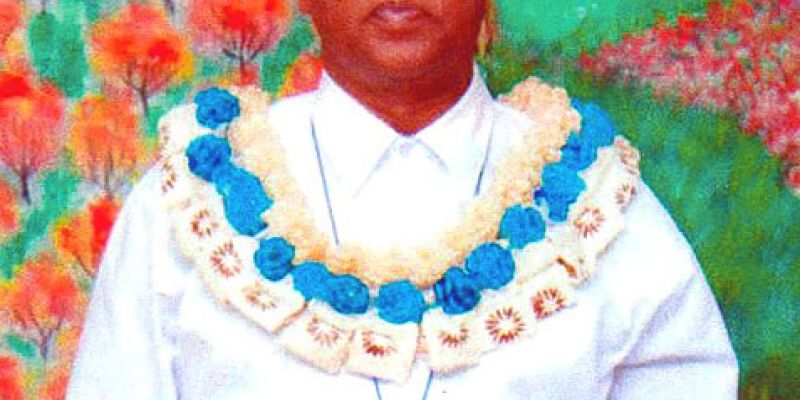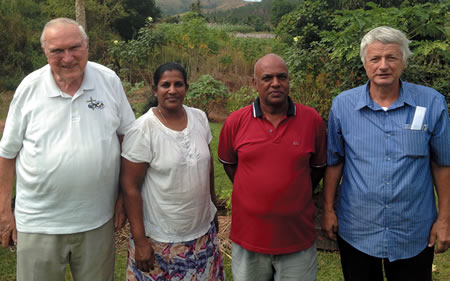
Fijian Catechists
“I couldn’t manage without them.” That is a phrase one often hears in a discussion between the parish priests in Fiji, whether indigenous or foreign born. They are speaking of the male catechists who serve in both rural and urban areas. These are not highly trained “professional” (and usually paid) religious educators which are found in some mission countries. A better description might be “dedicated village prayer leaders” who, along with their wives, have received some training.

Want, Vakuvuvuli Ignatiuse Gyan Want
and Columban Fr. Paul Tierney
While there were catechists earlier in the nearly 200 year history of the Catholic Church in Fiji, the present system was inaugurated some forty years ago by Columban Fr. Jim Gavigan, now retired in Ireland. The system works like this. Parishes in Fiji, particularly in rural areas, are composed of small villages ranging from just a few houses up to perhaps one hundred. The houses are close together, usually around a central grass square which is often times the site of the local chief ‘s house and in some cases, a small chapel. The residents then go to their surrounding small plots of root crops, vegetable, cocoanut harvesting or other cash crop like kava or yaqona, the national nonalcoholic drink in Fiji made from the roots and lower branches of shrubs that take some years to mature which is used widely both in ceremonies and recreation. Usually this work is done individually, but often tasks are undertaken on a community basis.
In consultation with the parish priest, the villagers select a man from their village to begin training as their catechist. Those so selected will begin training at the Navesi Catechetical Center near the capital city of Suva. The men, their wives and their small children live at the Center for three months a year for three successive years of participation in the preparation program.
Meanwhile, back in the village, if the system is working as designed, their fellow villages are looking after the candidates’ root crops and gardens and care for their older children during their absence at the Center. If possible, villagers try to bring in food from time to time to the Center as well to help defray expenses.
The candidates themselves engage in various courses: basic theology, scripture, liturgy, church history, communications and ongoing spiritual formation. They also participate in some hours of manual work each day to tend to the gardens of the Center. Their wives are involved in various courses and selected home making skills. If all goes well, at the end of the three year program, the candidates will be commissioned as catechists by the Archbishop and given their official signs of office: a small crucifix to hang around their necks and a blue sash waistband. When functioning officially in their new ministries, the men wear those items and are dressed in a white shirt and white sulu, the skirt like apparel with pockets which is worn by Fijian men on formal occasions.
Once they return home, depending on the circumstances, the newly commissioned catechists are engaged in many various functions within the village and surrounding areas. The most important is conducting the Sunday para-liturgical celebrations, as many villages because of location only have Mass celebrated in them perhaps once a month or in some more isolated places just a few times a year. The service is comprised of the basic components of the first part of the Mass: the official prayer of the day, the Scripture readings for that Sunday or Feast Day, a homily given by the catechist followed by the Profession of Faith, the Prayers of the Faithful, and a Communion service if the Blessed Sacrament is reserved in the village. Of course the entire service is punctuated by hymns in Fijian, Hindi or English, depending on the area, which are sung with great enthusiasm and in four part harmony which seems to come so natural to the Fijian people.
Besides the Sunday service, the catechist will be involved in a wide range of spiritual activities, again depending on the area. These usually would include calling together the village residents for morning and night prayers, home visitation, assisting parents and godparents to prepare for the baptism of their children, helping in Confirmation and First Holy Communion preparation as well as assisting in the preparation of young couples for marriage. In general, they are the liaison or contact person between the Catholics of the area and their parish priest. Ideally all the catechists in a parish will meet with their pastors monthly to review upcoming activities in the parish and spend time in prayer and reflection together, “recharging their spiritual batteries,” so to speak, for another month.
Villagers are encouraged to select their candidates carefully. While the pastor and assistant priests are transferred to different parishes from time to time, their catechist normally will be serving them until retirement, a virtual lifetime appointment. Before the new system was introduced around 1972, the few catechists in Fiji could be assigned to any parish in the country. As such, they had no direct connection with the people they were serving. The genius of the present system lies in the fact that the catechists are members of their local sub-tribal groupings, speak the local dialect, and are familiar with the relationships, the history and traditions of the people to whom they minister. It is strictly a volunteer WWW.COLUMBAN.ORG August/September 2016 21 service and catechists receive no salary or stipend although they may be reimbursed for expenses associated with their activities like travel.
I can personally witness both the necessity and value of a good team of catechist in a parish. In one of the parishes to which I was assigned, which is rather remote at the end of Fiji’s second largest island of Vanua Levu, there were twelve catechists (a strong Scriptural number) as several of the villages served were remote and transportation was difficult. When I left there after seven years, it was like leaving twelve brothers. Similar deep relationships and friendships with catechists developed as well in the other parishes in which I served. The longer I was in Fiji, the more I realized how dependent I was on them.
In looking back at those years, I am reminded that Jesus told His apostles before returning to His Father that they were to “go into the whole world and teach all nations.” The Catholic Church was brought to Fiji by men and woman over the decades and centuries who heeded that call. In a sense, the catechists in Fiji continue that response. The only difference is that their “whole world” is more circumscribed. Their lives and generous service are a great example of lay people responding to the missionary dimension of every Christian’s baptismal call. As St. Paul says in writing to the Romans, “the footsteps of those who bring Good News is a welcome sound.” These catechists are not crossing boundaries of language, distance and culture like the foreign missionaries who brought them the faith, but their footsteps indeed are welcome sounds amid the hills and valleys of Fiji.
Columban Fr. Charles Duster lives and works in St. Columbans, NE.


 The Columbans are a society of missionaries, including priests and lay people, who minister to people of various cultures as a way of witnessing to the universal love of God.
The Columbans are a society of missionaries, including priests and lay people, who minister to people of various cultures as a way of witnessing to the universal love of God.